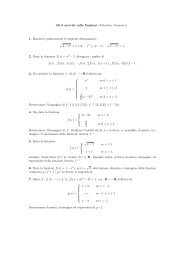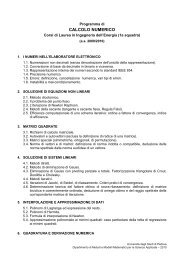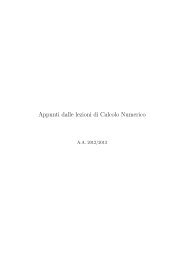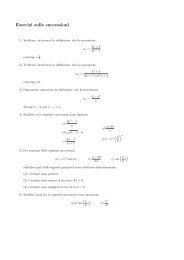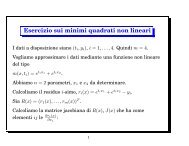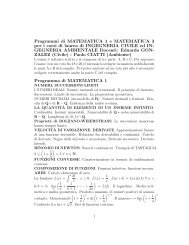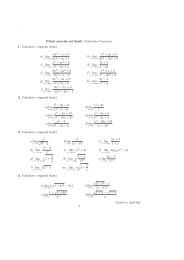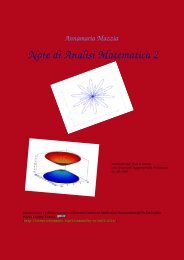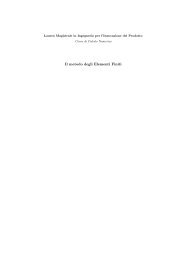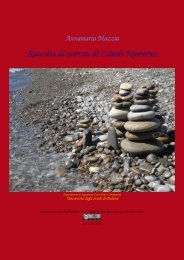Appunti di Calcolo Numerico - Esercizi e Dispense - Università degli ...
Appunti di Calcolo Numerico - Esercizi e Dispense - Università degli ...
Appunti di Calcolo Numerico - Esercizi e Dispense - Università degli ...
You also want an ePaper? Increase the reach of your titles
YUMPU automatically turns print PDFs into web optimized ePapers that Google loves.
10. INTEGRAZIONE NUMERICA<br />
<strong>Esercizi</strong>o 10.8.3 Dato l’integrale<br />
∫ 0.5<br />
1<br />
I = d x<br />
1 − x<br />
2<br />
0<br />
(a) si approssimi I con i valori Q 1 e Q 2 ottenuti applicando il metodo <strong>di</strong> Cavalieri-Simpson prima a tutto<br />
l’intervallo e poi sud<strong>di</strong>videndo l’intervallo in due parti uguali;<br />
(b) si approssimi I usando la formula <strong>di</strong> estrapolazione <strong>di</strong> Richardson;<br />
(c) dopo aver calcolato analiticamente il valore esatto <strong>di</strong> I , determinare l’errore esatto commesso con<br />
l’estrapolazione <strong>di</strong> Richardson.<br />
Svolgimento<br />
(a) Applichiamo la formula <strong>di</strong> Cavalieri-Simpson su tutto l’intervallo, considerando che l’ampiezza<br />
dell’intervallo è b − a = 0.5<br />
Q 1 = 0.5 (f (0) + 4f (0.25) + f (0.5)) = 0.523823565<br />
6<br />
Si ha, infatti, f (0) = 1, f (0.25) = 1.03279556 e f (0.5) = 1.15470054.<br />
Sud<strong>di</strong>videndo l’intervallo in due parti uguali, abbiamo h = 0.25, da cui i punti: x 0 = a = 0, x 1 = 0.125,<br />
x 2 = 0.25, x 3 = 0.375, e x 4 = b = 0.5.<br />
Q 2 = h 6 (f (x 0) + 4(f (x 1 ) + 4f (x 3 )) + 2f (x 2 ) + f (x 4 )) = 0.523616326<br />
dove f (0.125) = 1.00790526, f (0.375) = 1.07871978 (essendo già in possesso <strong>degli</strong> altri valori, calcolati<br />
per Q 1 )<br />
(b) La formula <strong>di</strong> estrapolazione <strong>di</strong> Richardson è: I R = Q 2 + Q 2 −Q 1<br />
da cui ricaviamo I R = 0.5236025101<br />
15<br />
(c) Analiticamente l’integrale esatto è:<br />
I =<br />
∫ 0.5<br />
0<br />
1<br />
<br />
1 − x<br />
2 d x = arcsin(x)|0.5 0 = π/6 − 0 = 0.523598775<br />
L’errore esatto commesso con l’estrapolazione <strong>di</strong> Richardson, in valore assoluto, è: |I −I R | = 3.7351·<br />
10 −6 .<br />
<strong>Esercizi</strong>o 10.8.4 Si calcoli I = ∫ 5<br />
2 sin( x) d x utilizzando il metodo <strong>di</strong> Gauss-Legendre con 3 punti <strong>di</strong><br />
appoggio (x 1 = − (3/5), x 2 = 0, x 3 = (3/5); w 1 = w 3 = 5/9, w 1 = 8/9).<br />
Svolgimento<br />
Applichiamo la formula, ricordandoci che dobbiamo utilizzarla non in [2,5] ma in [−1,1]. Considerando<br />
che la trasformazione dall’intervallo [2,5] all’intervallo [−1,1] porta al cambiamento <strong>di</strong> variabili x = b − a<br />
2 t +<br />
b + a<br />
= 5 − 2<br />
2 2 t + 5 + 2 = 3 2 2 t + 7 2 si ha d x = 3 d t. La formula <strong>di</strong> Gauss-Legendre deve essere applicata sui no<strong>di</strong><br />
2<br />
trasformati dati da 3 2 x i + 7 . Perciò abbiamo<br />
2<br />
I G = 3 (w 1 f ( 3 2 2 x 1 + 7 2 ) + w 2 f ( 3 2 x 2 + 7 2 ) + w 3 f ( 3 2 x 3 + 7 )<br />
2 )<br />
= 1.5 ( (5/9)f (−1.161895004 + 3.5) + (8/9)f (3.5) + (5/9)f (1.161895004 + 3.5) )<br />
= 1.5(0.5550723689 + 0.8491794877 + 0.4621443545) = 2.799594317<br />
164



